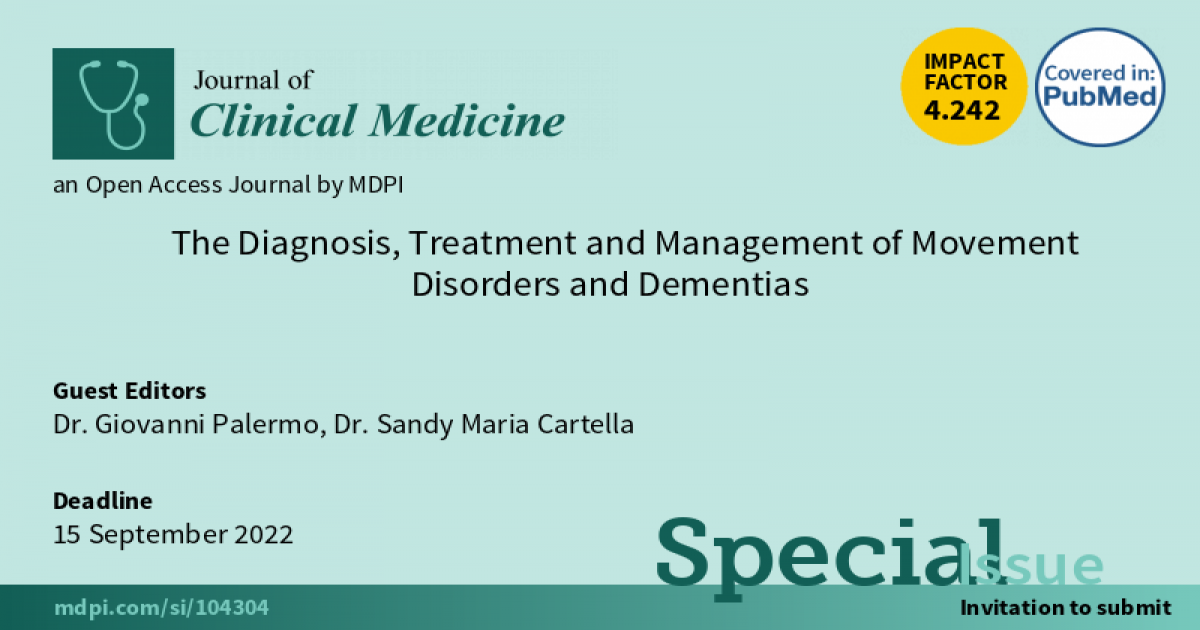The Diagnosis, Treatment and Management of Movement Disorders and Dementias
A special issue of Journal of Clinical Medicine (ISSN 2077-0383). This special issue belongs to the section "Clinical Neurology".
Deadline for manuscript submissions: closed (15 September 2022) | Viewed by 15923

Special Issue Editors
Interests: Parkinson’s disease; dementia with Lewy bodies; Huntington’s disease; atypical Parkinson syndromes; tremor; dystonia; imaging and blood biomarkers in Parkinson’s disease and Lewy body dementias
Interests: Parkinson’s Disease; Dementia with Lewy Bodies; atypical parkinsonisms; dystonia; tremor; Huntington’s Disease; cognitive impairment in Movement Disorders patients; functional movement disorders
Special Issue Information
Dear Colleagues,
On behalf of the Journal of Clinical Medicine (JCM) Editorial Team, we are delighted to present a new Special Issue on the topic of “The Diagnosis, Treatment and Management of Movement Disorders and Dementias”, Guest Edited by Dr. Giovanni Palermo, from the University of Pisa, and Sandy Maria Cartella from the University of Messina (Italy).
Movement disorders comprise a large group of conditions commonly encountered in the clinic. Although the diagnostic process is frequently perceived as being complex, recent developments have vastly improved our understanding of these disorders, generating a considerable array of tools which can support clinician in the diagnosis. The phenomenology of the clinical syndrome remains what guides the diagnosis but new classification systems and diagnostic criteria have been proposed for several movement disorders with the incorporation of paraclinical investigations and available biomarkers. Similarly, there is an urgent need of disease-modifying therapies and, as understanding of their pathogenesis grows, new therapeutic avenues to prevent disease or restore brain function are likely to emerge.
Therefore, the aim of this special issue is to highlight the progress that has been made in this area, providing an update in the fields of diagnosis and treatment of Movement Disorders, with special emphasis to Parkinson’s Disease which is the second most common neurodegenerative disease, affecting more than 10 million people worldwide.
Dr. Giovanni Palermo
Dr. Sandy Maria Cartella
Guest Editors
Manuscript Submission Information
Manuscripts should be submitted online at www.mdpi.com by registering and logging in to this website. Once you are registered, click here to go to the submission form. Manuscripts can be submitted until the deadline. All submissions that pass pre-check are peer-reviewed. Accepted papers will be published continuously in the journal (as soon as accepted) and will be listed together on the special issue website. Research articles, review articles as well as short communications are invited. For planned papers, a title and short abstract (about 250 words) can be sent to the Editorial Office for assessment.
Submitted manuscripts should not have been published previously, nor be under consideration for publication elsewhere (except conference proceedings papers). All manuscripts are thoroughly refereed through a single-blind peer-review process. A guide for authors and other relevant information for submission of manuscripts is available on the Instructions for Authors page. Journal of Clinical Medicine is an international peer-reviewed open access semimonthly journal published by MDPI.
Please visit the Instructions for Authors page before submitting a manuscript. The Article Processing Charge (APC) for publication in this open access journal is 2600 CHF (Swiss Francs). Submitted papers should be well formatted and use good English. Authors may use MDPI's English editing service prior to publication or during author revisions.
Keywords
- Parkinson’s Disease
- atypical parkinsonisms
- Lewy body dementias
- Dystonia, Functional Movement Disorders
- Movement disorders
- Treatment
- Diagnosis
- Imaging
- Biomarkers
Benefits of Publishing in a Special Issue
- Ease of navigation: Grouping papers by topic helps scholars navigate broad scope journals more efficiently.
- Greater discoverability: Special Issues support the reach and impact of scientific research. Articles in Special Issues are more discoverable and cited more frequently.
- Expansion of research network: Special Issues facilitate connections among authors, fostering scientific collaborations.
- External promotion: Articles in Special Issues are often promoted through the journal's social media, increasing their visibility.
- Reprint: MDPI Books provides the opportunity to republish successful Special Issues in book format, both online and in print.
Further information on MDPI's Special Issue policies can be found here.






